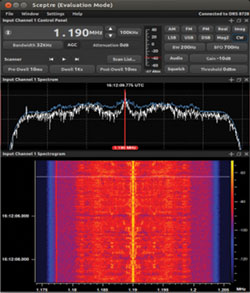
Thousands of individual signals are present in the high frequency (HF) spectrum. Often, the most difficult problem is to discern and capture a small signal in the presence of large interfering signals. DRS Signal Solutions’ SI-8728A HF tuner is a best-in-class RF front-end for receiving small signals in dense signal environments. The SI-8728A is operationally proven, with several hundred units deployed on program platforms.
The SI-8728A is capable of continuous
1 Hz tuning resolution over the frequency range of 100 kHz to 30 MHz, while each of its tuner channels provides an instantaneous IF bandwidth of 25 kHz. The SI-8728A’s very high density design, high dynamic range, VITA radio transport standard precision time-stamped I/Q data and non-blocking switch options, coupled with an easy-to-use graphic user interface (GUI), make the unit a best-in-class HF tuner.
The SI-8728A provides up to eight digital HF tuner channels in a compact 1U rack-mount chassis, half the size of the nearest competing unit. Its attractive low size, weight and power (SWAP) design includes a weight of less than 18 pounds and an internal power supply that accepts 100 to 250 VAC. This design and its extended temperature range of -20° to +60°C allow multiple units to stack for high-density systems.
With its eight channels, the SI-8728A can be remotely configured for independent or phase-coherent operation to support a variety of system applications. Possible applications for the SI-8728A include a high density HF monitor system, a phase-coherent tuner for super-resolution DF systems and a front-end for HF systems based on software-definable radio. The tuner provides flexibility to operate up to eight channels independently, up to eight channels phase-coherently or with a mix of some channels operating independently and the remaining phase-coherently. Simultaneous control of the SI-8728A’s multiple tuner channels is controlled remotely using a Gigabit Ethernet interface and TCP/IP.
The SI-8728A features high dynamic range and low phase jitter. Amplitude and phase distortion within each channel are minimized as well as amplitude and phase mismatch among channels. The tuner is designed to expend very low emissions for operation in electromagnetic interference (EMI) sensitive environments. It may also be configured and used for precision direction finding and rapid signal analysis. A built-in self-test calibrator ensures that the unit functions properly.

Figure 1 Graphical user interface for the SI-8728A.
Each channel’s IF output is processed digitally and made available as baseband in-phase and quadrature-phase (I/Q) data. The tuner features an analog-to-digital converter (ADC) that digitizes data that is passed to the digital signal processor (DSP), where it is filtered and decimated, resulting in a complex data output. The processed data outputs are packaged according to the packet structure of VITA 49.0 for output via the Ethernet interface. A real time clock is maintained for time-stamping the processed data. This clock may be synchronized to an external one-pulse-per-second (1 PPS) reference input.
The SI-8728A control GUI interface is simple to use and allows for easy signal detection, signal analysis, signal recording and digital playback. Its narrowband real time continuous fast Fourier transform (FFT) is shown with a spectral display and a waterfall display that depicts a spectrum’s activity over time using color to indicate signal strength (see Figure 1).
OPTIONS AND AUXILIARY EQUIPMENT
The 8728A/MULTI Switch Matrix option adds an 8×8 fully non-blocking matrix internal to the SI-8728A chassis. It allows any combination of eight antennas to be connected to any combination of tuner channels. The switch matrix is controlled through the same 1000Base-SX or 1000Base-T interface as the tuner, for ease in deployment. This switch matrix option limits its RF output power when a large RF input is applied, protecting sensitive RF input circuitry from high voltage transients and nearby lightning strikes.
Four SI-8728A units can be combined with one SI-9332, 32´32 HF fully non-blocking switch matrix. The SI- 9332 receives up to 32 HF inputs in the 0.5 to 30 MHz range and provides up to 32 outputs. Any of the 32 SI-8728A channels can access any of the 32 SI-9332 inputs, allowing operational flexibility. The switch matrix provides near unity (0 dB) gain so that it is virtually transparent in system operation. The unit offers excellent intermodulation, noise figure and internal spurious performance.
DRS Signal Solutions
Germantown, Md.
www.drs.com
